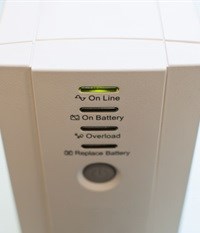
Subscribe & Follow
Advertise your job vacancies
Jobs
UPS vs AVR and why your business needs both
Given the current and very real power crisis in South Africa, and the fact that it is set to continue for the foreseeable future, a generator coupled with an Uninterruptable Power Supply (UPS) is fast becoming essential equipment for both businesses and households. Minimising the disruption caused by load shedding is the ultimate goal, and utilising a UPS in conjunction with a generator can create seamless failover between utility and backup power.
However, power assurance solutions such as these are not enough on their own, as even when utility power is running, it may be unstable. This causes voltage fluctuations such as transients, harmonics, surges and dips that can seriously damage sensitive electronic and computer equipment and cause data corruption, not to mention shortening the lifespan of all appliances. An Automatic Voltage Regulator (AVR), which offers power quality, in conjunction with power assurance solutions, is the ideal solution for ensuring a consistent supply of clean power.

©Aleh Datskevich via 123RF
Each organisation will have its own unique requirements
When it comes to power assurance solutions, each organisation will have its own unique requirements as well as challenges with regard to electrical and environmental circumstances. While the majority of organisations understand the need for a UPS to act as a bridge between utility power and generator power, ensuring a smooth and seamless transition, the role of the AVR is not as well understood.
One of the most common misconceptions for businesses looking to purchase a UPS is that it will automatically include AVR functionality. The reality is that this is often not the case, and while some UPS solutions do incorporate AVR, many do not, which requires the AVR unit to be purchased separately. UPS' with included AVR also tend to have very basic AVR functionality, which is often limited in bandwidth to deal with unstable mains, resulting in the UPS using batteries to ride these situations out.
AVR's primary purpose
An AVR's primary purpose is to stabilise voltage fluctuations caused by unstable mains supply from the local utility. While load shedding and power outages cause an instantaneous cut-off of power, even when power is available it is often not delivered at a stable voltage. This has a number of implications.
Firstly, dips in available power may cause generators to start up unnecessarily and run even while utility power is available. In addition, fluctuations in voltage can degrade the life of electronic components, potentially causing premature failure, and can cause data corruption on hard drives. Large surges can also burn equipment out, causing instantaneous failure. An AVR not only adjusts voltages to safe levels, it ensures a steady and constant power supply by automatically regulating the voltage at the appropriate level, by the decline during the surge or the increase when voltage drops in the power line.
An AVR will extend the life of sensitive equipment. It will also ensure that the Automatic Mains Failure (AMF) panel on generators, which is responsible for starting the generator when utility power fails, does not activate unnecessarily. The AMF is typically set to start up if more than 10% of the voltage is lost, however, in South Africa this is not an uncommon occurrence and does not necessarily necessitate generator power. An AVR will condition the power and prevent this from happening. An AVR can also be installed in front of the UPS to ensure that the UPS does not go into battery mode due to excessive high or low voltage, thereby extending the life of the UPS batteries.
The many applications of AVR
An AVR has many applications, and can be used with any type of electrical equipment in a number of environments. These include data centres and other IT infrastructure, communications solutions and industrial equipment. An AVR can also be used in inductive applications, such as low-frequency equipment, heating and cooling systems, where a UPS is not compatible.
AVRs are either installed at the main distribution board or directly in front of the connected equipment. AVRs can also be installed in front of the UPS or the UPS bypass in online double conversion technologies so should a static bypass occur one still enjoys stable voltage.
Ensuring your business obtains the right AVR solution for power quality, and implements these solutions in the most appropriate manner, will require partnering with a reputable power solutions provider. Such a provider will be able to effectively assess, design and implement a compatible AVR solution depending on the electrical and environmental circumstances of a particular business.








